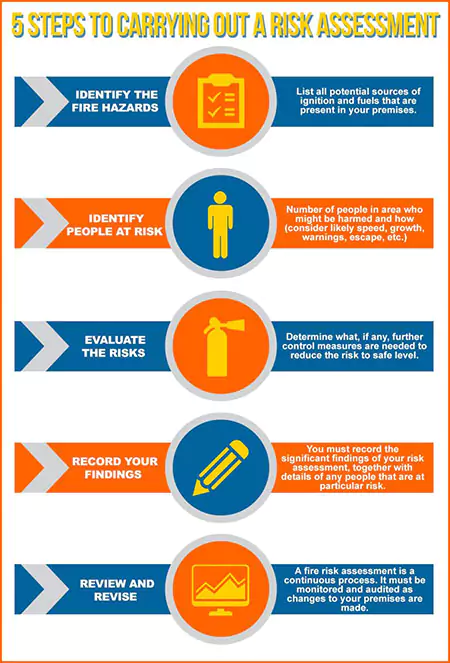Fire risk assessments are a legal obligation for certain commercial properties in the UK. Failure to comply can result in legal repercussions, so it is important to follow the law and have a fire risk assessment on your property or premises.
Conducting a Fire Risk Assessment can seem to be quite a complex process for many people.
You may have heard that there are 5 steps to a fire risk assessment, but do you want to find out what is involved and how you should approach one?
Here’s a simple guide to the 5 main steps in a Fire Risk Assessment:
Identify fire hazards
Think about how a Fire could be started in the property. Fire starts when a source of ignition (heat) meets combustible materials. You may have heard this referred to as the fire triangle
Some sources of ignition may be obvious, such as electrical metres, heaters, naked flames, cooking equipment etc.
Some sources of ignition might not be so obvious, for example, overload of electrical sockets. It is important to consider what is plugged in to extension leads, is items such as laptops/phones are being charged and how long they are being left in as this can lead to overheating.
Consider which materials are combustible / flammable and would burn easily. Some examples of this may include rubbish, furniture and textiles, cardboard/wooden furniture.
More recently the increased use of hand sanitiser has introduced a flammable substance into areas, which may not normally house anything combustible, for example entrance lobbies.
Identify people at risk of fire
All people are at risk in the event of a fire breaking out. Think about who is in the building/nearby and what time of day/night they will be there.
Some people will be at higher risk than others, for example those with mental or sensory impairments or those with mobility issues. Those at greater risk may also include contractors and visitors who are not familiar with the property.
People who are sleeping on a premises are also at a higher risk, as it takes longer to alert a sleeping person and then there is additional time for them to react to the warning. Who might be more vulnerable if a fire starts?
Take Action to prevent fire
After thinking about potential hazards and who may be affected, think about what action can be taken. What can be done to eliminate these risks or prevent accidental fires from happening?
Education and training is vitally important. The more understanding occupants of the building have around can cause a fire, the more they can help to prevent it.
You also need to protect people in the building should a fire break out. In the event of a fire occurring, consider:
- How will people be alerted?
- How will they escape?
- Are the escape routes safe?
- Will the Fire Safety Equipment work?
Regularly testing and maintaining fire safety equipment, should be an important part of the fire safety regime.
Record findings, plan and train
Make sure that you keep a record of any hazards found in your property, as well as the actions taken to reduce or remove them.
Recording findings however, will help to highlight recurring areas of concern, which in turn may highlight training issues or maintenance requirements. Having a written record, also shows you’ve taken every precaution to mitigate the risks, should a fire occur. .
You should have a clear plan on what everyone should do if a fire does break out – if you share the building with others you may have to coordinate with them. If you employ persons on the premises you must carry out at least one fire drill a year and in some cases you may have to train staff as fire wardens/marshalls, to help maintain fire safety and ensure evacuation is carried out in a timely manner.
Review and update regularly to reduce the risk of fire
Regularly review your Fire Risk Assessment – over time the risks or hazards in a building may change. This can be changes in occupancy either increase or decrease, both daytime and at night.
Fire safety management could have changed, it could have become more robust or it may have lapsed. Fire safety equipment may have become less efficient over time and require replacement Check to make sure that it is still up to date, no significant changes have been made, and all hazards/risks have been suitably addressed.
Should any significant changes be made to the building, including layout, or the use of the building, a new Fire Risk Assessment should be conducted
Risk to life and risk of fire occurring
Overall a fire risk assessment takes into consideration all aspects of both the potential for fire to start and the overall risk this poses to the occupants.
Having a high risk of a fire starting in your premises does not always mean it is unsafe. This could potentially be mitigated by having a very robust fire safety management system in place, alongside some very effective fire protection equipment.
On the flip side, there may be a very low risk of fire occurring in the premises, but due to lack of any fire safety management and out of date fire protection equipment, the risk to persons in the premises could be quite high.
Find out how we carry out a fire risk assessment for you and what the report will include.

